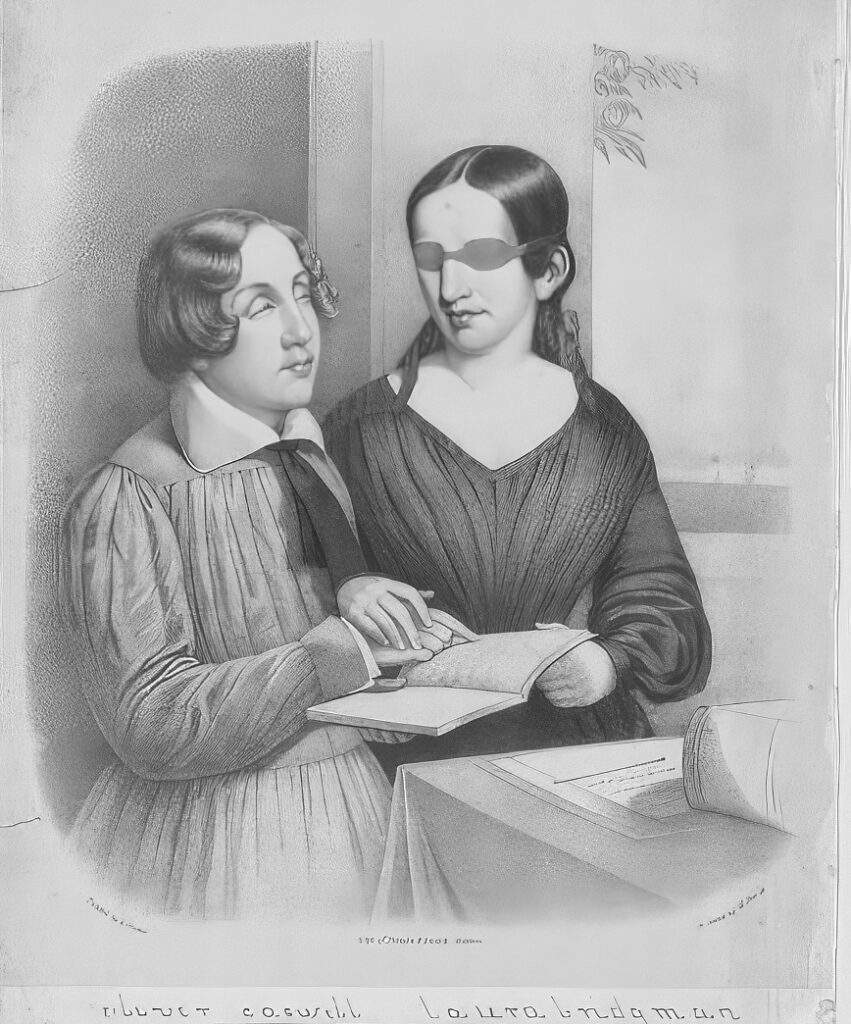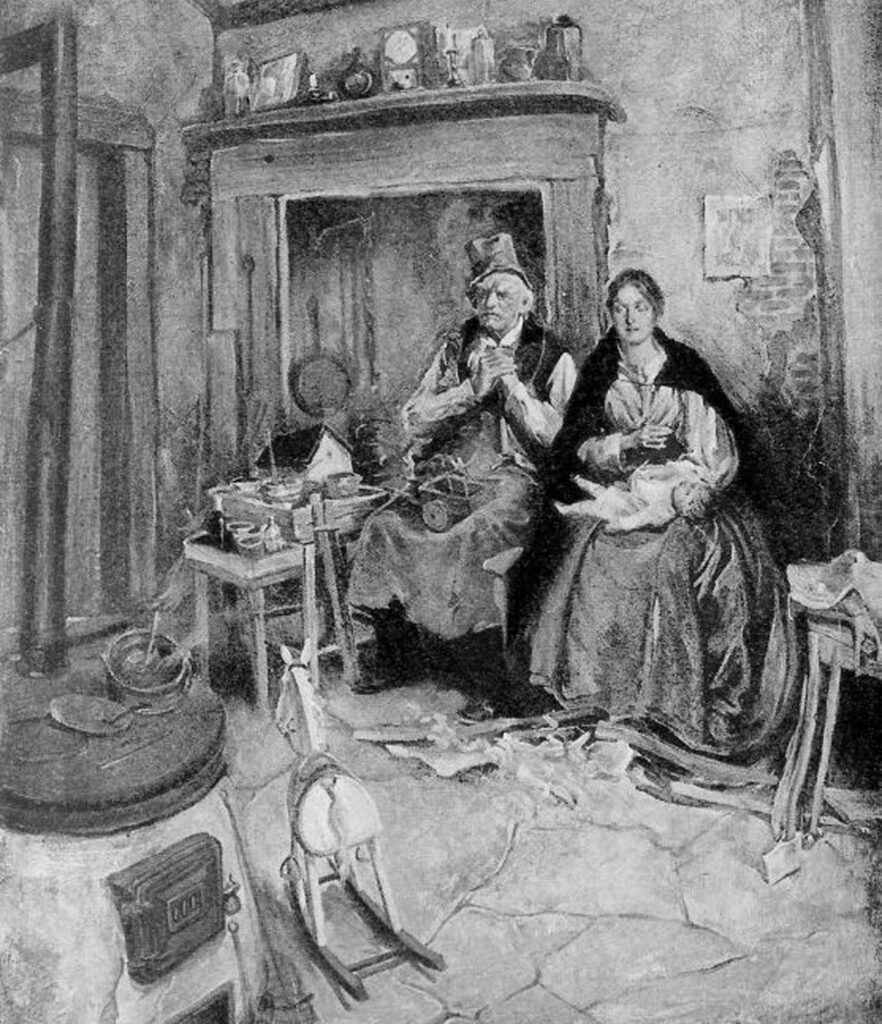Curtis Margo
Lynn Harman
Tampa, Florida, United States

Charles Dickens (1812–1870), the most recognized English author after Shakespeare, left a legacy of fictional characters, many of whom are inseparably associated with the cruelties of the Industrial Age, poverty, and disability. On his first trip to America, Dickens went out of his way to meet Laura Bridgman (1829–1889), the first deafblind person to learn language. He then described this encounter in some detail in his travel book American Notes. Three years later he published a Christmas story, The Cricket on the Hearth, a novel that featured a blind woman—Bertha Plummer.1,2 It has been widely assumed that Bridgman was the inspiration for Bertha.3-5 The astute and inquisitive Bridgman, however, was the antithesis of Bertha, who was portrayed as laughably naive. The effects of blindness on the life of Bertha were also treated callously. There exists an incongruity in the respect Dickens paid to Bridgman and the contempt he displayed for his fictional character Bertha that has not been sufficiently addressed.
Background
In 1845, Charles Dickens published his third Christmas story, titled The Cricket on the Hearth: A Fairy Tale of Home, which featured a young blind woman named Bertha Plummer.2 Like many of Dickens’s creations, “Bertha the Blind Girl,” as he referred to her, became a symbol of Victorian misfortune, albeit not as well-known as Oliver Twist or the Artful Dodger. Dickens was renowned for using real people as templates for his fictional characters. When portraits were poorly disguised, they invited civil litigation, as nearly occurred when Dickens used the one-eyed William Shaw, the headmaster of a Yorkshire school for boys, for the vile monocular schoolmaster Wackford Squeers in Nicholas Nickleby.6 Three years before Dickens wrote The Cricket on the Hearth, he visited the Perkins Institution for the Blind in Boston specifically to meet Bridgman and Samuel Gridley Howe (1801–1876), the school’s founder and innovative educator.7,8
Samuel Gridley Howe and the Perkins Institution
Howe graduated from Harvard Medical School in 1824 and then volunteered to serve as a surgeon in the Greek war of independence from the Ottoman Turks. After returning to Boston seven years later, his commitment to the foreign revolution was seen as heroic.9 While the young physician pondered his options, several local philanthropists offered him the directorship of a proposed asylum for the blind. In 1831, he accepted the challenge, then familiarized himself with the modern advances made in the education of the visually impaired, relying heavily on the work of Valentin de Haüy, who founded the National Institution for Young Blind Children in Paris in 1784. After a local merchant named Thomas Perkins donated a large building on Pearl Street to the asylum, the first school for the blind in America was renamed accordingly.9
Once the Perkins Institution was up and running, Howe’s interest turned to resolving an old epistemological question: whether minds are born with innate ideas, or if ideas are acquired through sensory experience. To test the hypothesis, he needed a young child born deafblind.
Laura Bridgman
After hearing about a seven-year-old deafblind girl living with her parents in New Hampshire, Howe visited the family and convinced them to send her to the Perkins Institution.10 Though not born deafblind, Laura Bridgman lost her vision and hearing following a bout of scarlet fever at twenty-five months of age, before she demonstrated any proclivity towards verbal communication. It later became evident that she also lost her sense of smell. Both eyes had ruptured and drained during her acute illness. She was otherwise healthy, but her parents kept a scarf over her empty orbits to conceal the deformities. Laura could communicate through crude signs and had become increasingly difficult to manage at home.
The intense, compassionate, and time-consuming effort to teach Laura language took years to achieve, but she made remarkable early progress under the supervision of Howe. The rapidity with which she bonded with the blind girls in the institute was a clue to her potential. Laura was taught separately because of her unique needs. Once she grasped the abstract concepts of language through the sense of touch (finger writing), her interests in the outside world blossomed. Laura’s development was so extraordinary that Howe began to publicly exhibit her mastery of language to promote the Perkins Institution (Fig 1). Her comportment before audiences made her a regional celebrity. When news of the first deafblind person to learn language reached Europe, Dickens decided he wanted to meet this exceptional individual.
Charles Dickens
Having lived most of his life in urban, industrial England, Dickens used this as the backdrop for many of his fabled characters.11 His stories and novels range from comedic and historical to implausible. He was and continues to be viewed as a liberal reformer who raised awareness of social injustice.7,8,11 How Dickens depicted some characters with physical disabilities, however, has generated modern criticism.3 One example is Bertha in The Cricket on the Hearth.2

Bertha Plummer, the “Blind Girl”
The subtitle “A Fairy Tale of Home” seemingly contradicts the principal theme in this Christmas story of deception. Bertha has been misled her entire life into believing she lives in a beautiful home and wears nice clothes by her father, Caleb, a downtrodden toy maker who works for a tyrannical merchant. Bertha actually lives in a dirty, cluttered hovel, and her father is exploited by his employer (Fig 2). Although Caleb’s motives to shield his daughter from the realities of their miserable existence may have been well-intended, Bertha comes off as hopelessly gullible and simple-minded. Because of her father’s deception and lies, she finds herself in love with the mean-spirited owner of the toy shop whose insults she is oblivious to. Dickens manages to manipulate this and one other subplot of duplicity so that on Christmas Day all lies are revealed and forgiven. The cast of deluded characters now rejoices. After discovering she has lived a life of fabrications, Bertha, incredulously, delights: “I have been blind, and now my eyes are open.”2p229 As every sighted character in the story unites in celebration with a Yuletide dance, Bertha is left alone—an outcast playing the harp.
Blindness in Victorian England
The Cricket on the Hearth was briefly popular. Some may have found its exaggerated romanticism a bit mawkish. Vladimir Lenin famously walked out on the play because of its “middle class sentimentality.”12 Blindness was a simple way for Dickens to introduce a character who could be easily preyed upon and possibly not know it. He may have developed the idea of portraying the blind as helpless victims from Chaucer’s The Merchant’s Tale, in which a young woman could have an open affair without her old, blind husband suspecting it.11p64 Blindness could also be portrayed with such insensitivity because prevailing attitudes toward the blind in Europe had gradually shifted since the late Middle Ages from pity to suspicion and derision.13,14
Was Bridgman a role model?
Dickens did not have to travel to Boston to observe the blind. Like other large European cities, London had a substantial population in the streets and asylums.15 Bennett George Johns (1820–1900), a chaplain for the Blind School of St. Georges’ Fields, estimated that 30,000 blind existed in Great Britain in 1867, and that most could not afford living in an asylum.16p70 The second asylum for the blind in England was opened in 1799 in Southwark, London, a forty-minute walk from where Dickens lived and worked. Dickens likely wanted to meet Bridgman because she had become a celebrity in having been the first person to transcend her profound sensory deprivation. His first opinion of her was high, remarking: “Her face was radiant with intelligence and pleasure.”1p32 When he learned from Howe what an agile mind she possessed, his admiration grew. This respect and veneration contrasts with the depiction of Bertha Plummer as extremely gullible, unable to formulate an independent opinion about her immediate surroundings or even appreciate when hurtful comments are directed to her.
Sophie Marigold is the only other fictional character of Dickens with a comparable sensory disability.16 Sophie, however, was deaf and appeared in an 1865 Christmas story called Doctor Marigold’s Prescriptions. Sophie too was raised by a widowed father, but in stark contrast to Bertha she was socially engaged. When Sophie fell in love, for example, her father encouraged her to marry, which she did.
Conclusions
The remarkable achievements of Laura Bridgman showed that the deafblind could learn language through touch and engage in social intercourse when afforded an education. Considered at one time the most famous woman in the world next to Queen Elizabeth,10p2 Laura changed the perception of the deafblind for the better. She was an unlikely inspiration for Dickens’s “Bertha the Blind Girl” in The Cricket on the Hearth. It is difficult to reconcile why Dickens viewed Bridgman with awe and deference yet fashioned a character for a Victorian Christmas story who was a fatuous stereotype of the blind.
References
- Dickens D. American Notes and Pictures from Italy. Printed serially, Daily Press, 1842. Reprinted in: The Oxford Illustrated Dickens. London, Oxford University Press, 1957.
- Dickens C. The Cricket on the Hearth. London, Bradbury and Evans, 1845. Reprinted in: A Christmas Carol and Other Christmas Books by Charles Dickens. Oxford, Oxford University Press, 2006.
- Rhodas JM. Tiny Tim, Blind Bertha, and the resistance of Miss Mowcher: Charles Dickens and the uses of disability. Dickens Studies Annual. 2004; 34: 51-97. https://www.jstor.org/stable/44372091
- Stoddard MH. Annotated comments. May 1998. LITMED, Literature, Arts, Medicine database. The Cricket on the Heath by Charles Dickens. https://medhum.med.nyu.edu/view/1317.
- Wikipedia. Dickens C. The Cricket on the Heath. https://en.wikipedia.org/wiki/The_Cricket_on_the_Hearth.
- Margo CE, Harman LE. Charles Dickens, trachoma, and blindness in pre-Victorian England. Surv Ophthalmol. 2018;63:275-80.
- Ackroyd P. Dickens. New York, HarperCollins Publishers, 1990.
- Slater M. Charles Dickens. New Haven, Yale University Press, 2009.
- Schwartz H. Samuel Gridley Howe: Social Reformer. Cambridge, Harvard University Press, 1956. https://archive.org/details/samuelgridleyhow00schw/page/n5/mode/2up.
- Freeberg E. The Education of Laura Bridgman. The First Deaf and Blind Person to Learn Language. Cambridge, Harvard University Press, 2001.
- Glancy R. Student Companion to Charles Dickens. Westport, CN, Greenwood Press, 1999.
- Orwell G. Charles Dickens. In A Collection of Essay by George Orwell, Garden City, NY, Doubleday & Company, 1954, pp 55-110.
- Barasch M. Blindness. The History of a Mental Image in Western Thought. New York, Routledge, 2002.
- French RS. From Homer to Helen Keller. A Social and Educational Study of the Blind. New York, American Foundation for the Blind, Inc., 1932.
- Phillips GA, The Blind in British Society. Charity, State and Community, c.1780-1930, Aldershot, Ashgate, 2004.
- Johns GB. Blind People: Their Works and Ways; with Sketches of the Lives of Some Famous Blind Men. London, Clowes and Sons, 1867. (Printed on demand by HardPress Publishing, Miami.)
- Dickens C. Doctor Marigold’s Prescriptions. All the Year Round (periodical). London, 1865. https://openlibrary.org/books/OL7246370M/Doctor_Marigold’s_prescriptions.
CURTIS E. MARGO, MD, MPH, is an anatomic pathologist and ophthalmologist who teaches at the Morsani College of Medicine, University of South Florida in Tampa, Florida. He is a member of the Cogan Ophthalmic History Society.
LYNN E. HARMAN, MD, is an instructor in ophthalmic surgery at the Morsani College of Medicine, University of South Florida in Tampa, Florida. She is a retired glaucoma specialist.
Highlighted in Frontispiece Volume 16, Issue 2 – Spring 2024

Leave a Reply